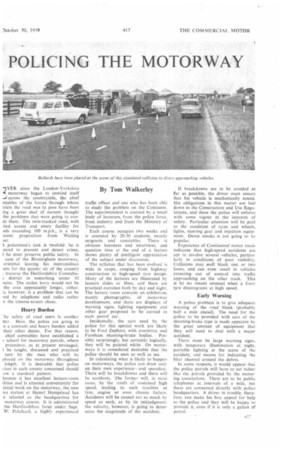POLICING THE MOTORWAY
Page 61

If you've noticed an error in this article please click here to report it so we can fix it.
By Tom Walkerley
VER since the London-Yorkshire 1 motorway began to unwind itself across the countryside, the chief tstables of the forces through whose tricts the road was to pass have been jog a great deal of earnest thought the problems that were going to connt them. The twin-tracked road, with ited access and every facility for eds exceeding 100 m.p.h., is a very erent proposition from Watling eet.
k policeman's task is twofold: he is uired to prevent and detect crime, I he must preserve public safety. In case of the Birmingham motorway, criminal leaving his metropolitan ints for the quieter air of the country ! traverse the Hertfordshire Constabuy district in something under 10 lutes. The stolen lorry would not be the area appreciably longer, either. Ls, however, is a problem that can be ved by telephone and radio rather n the cinema-screen chase.
Heavy Burden
he safety of road users is another tter. Here, the police are going to Pe a constant and heavy burden added their other duties. For that reason, chief constables have established a v school for motorway patrols, where procedure, as at present envisaged, be taught, discussed And practised turn by the men who will be ploved on the motorway throughout length. It is desirable that police vices in each county concerned should low a standard pattern.
tecause it has excellent lecture-room ititles and is situated conveniently for ctical work on the motorway, the new ice station at Hemel Hempstead has n selected as the headquarters for motorway course. It is administered the Hertfordshire force under Supt. W. Pritchard, a highly experienced
traffic officer and one who has been able to study the problem on the Continent. The superintendent is assisted by a small body of lecturers, from the police force, from industry and from the Ministry of Transport.
Each course occupies two weeks and is attended by 20-30 students, mostly sergeants and constables. There is obvious keenness and smartness, and question time at the end of a lecture shows plenty of intelligent appreciation of the subject under discussion.
The syllabus that has been evolved is wide in scope, ranging from highway construction to high-speed tyre design. Many of the lectures are illustrated by lantern slides or films, and there are practical exercises both by day and night. The lecture room contains an exhibition, mostly photographic, of motorway development, and there arc displays of warning signs, lighting equipment and other gear proposed to be carried in each patrol car.
Incidentally, the cars used by he police for this special work are likely to be Ford Zephyrs, with overdrive, and Farnham shooting-brake bodies. Possibly surprisingly, but certainly logically, they will be painted white. On motorways it is considered desirable that the police should be seen as well as see.
In calculating what is likely to happen on motorways, the police can draw only on their own experience—and speculate. There will be breakdowns and there will be accidents, The former will, in most cases, be the result of sustained high speed, leading to such troubles as tyre, engine or even chassis failure. Accidents will be caused not so much by speed as such, as by its misjudgment: the velocity, however, is going to determine the magnitude of the accident.
If breakdowns are to be avoided as far as possible, the driver roust ensure that his vehicle is mechanically sound. His obligations in this matter are laid down in the Construction and Use Regulations, and these the police will enforce with some vigour in the interests of safety. Particular attention will be paid to the condition of tyres and wheels, lights, steering gear and injection equipment. Dense smoke is not going to be popular.
Experience of Continental motor roads indicates that high-speed accidents are apt to involve several vehicles, particularly in conditions of poor visibility. Collisions may ,well block one or two lanes, and can even result in vehicles careering out of control into traffic approaching on the other track. This is by no means unusual when a front tyre disintegrates at high speed.
Early Warning A police problem is to give adequate warning of the road block (probably half a mile ahead). The need for the police to be provided with cars of the shooting-brake type is made apparent by the great amount of equipment that they will need to deal with a major accident.
There must be large warning signs, with temporary illumination at night, portable lighting at the scene of the accident, and means for indicating the filter channel around the debris.
In some respects, it would appear that the police patrols will have to act rather like the patrols provided by the motoring associations. There are to be public telephones at intervals of a mile, but these are connected directly with police headquarters. A driver in trouble, therefore, can make his first appeal for help to the police and they will be happy to provide it, even if it is only a gallon of petrol.




















































































































